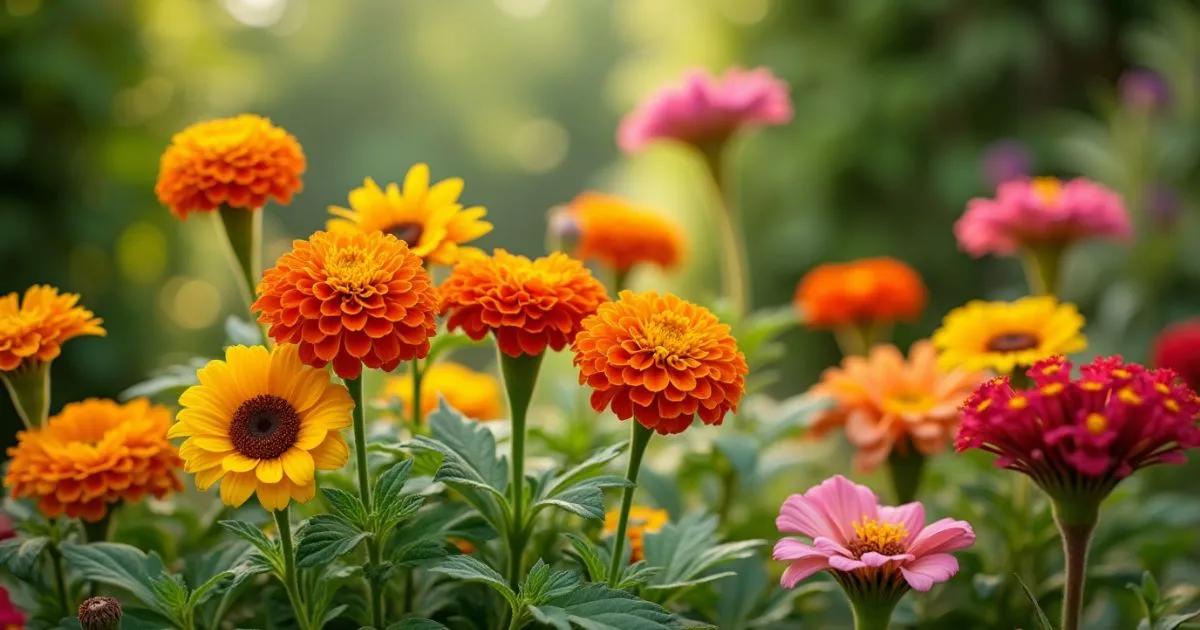In This Article
Introduction:
Dreaming of a colorful garden without the hassle? Growing flowers doesn’t have to be complicated or time-consuming. With the right easy-to-grow flowers, you can transform your outdoor space into a vibrant paradise—whether you’re a beginner or a seasoned gardener. These plants thrive with minimal effort, offering you the joy of blooming beauty all season long. Let’s explore how you can create a stunning garden with flowers that are simple to care for, but full of life and color!
Section 1: What Makes a Flower Easy to Grow?
Choosing easy-to-grow flowers can help you create a beautiful garden with minimal effort. But what makes some flowers simpler to care for than others? Knowing the traits that define low-maintenance flowers will help you make the best choices for your garden.
Characteristics of Easy-to-Grow Flowers
Easy-to-grow flowers are hardy, adaptable, and resilient. They thrive in various conditions, don’t need constant care, and are usually resistant to pests and diseases. These plants can handle different soil types and require minimal watering once established, making them ideal for beginners or busy gardeners.
Low-Maintenance Benefits
Selecting easy-to-grow flowers saves you time and effort while still giving your garden vibrant color and life. Since they require little attention, you’ll spend less time on watering, fertilizing, and pest control. These flowers are also perfect if you’re new to gardening, as they give you reliable blooms without demanding specialized care.
Best Choices for Beginners
Flowers like marigolds, sunflowers, and zinnias are perfect examples of easy-to-grow flowers. They’re durable, attractive, and often attract beneficial pollinators like bees and butterflies, which helps support your garden’s ecosystem. By focusing on these adaptable varieties, you can build a thriving garden that’s beautiful and rewarding.
Knowing these qualities can help you confidently choose the right plants to brighten your garden without the need for constant maintenance.
Section 2: Top 10 Easy-to-Grow Flowers for Your Garden
Selecting easy-to-grow flowers ensures a colorful garden with minimal work. Here are ten top choices that thrive with basic care, making them perfect for beginner and seasoned gardeners alike.
1. Marigolds
Marigolds are vibrant, pest-resistant flowers that adapt well to different soil types. They’re ideal for borders and add a warm, sunny hue to any garden.
2. Sunflowers
Known for their towering height and bright blooms, sunflowers are tough plants that need minimal watering. They attract pollinators and bring a cheerful look to any space.
3. Zinnias
Zinnias are durable flowers that come in a variety of colors. They’re drought-resistant and bloom consistently, adding long-lasting color to your garden.
4. Coneflowers (Echinacea)
With their daisy-like appearance, coneflowers are drought-tolerant and attract pollinators, making them both beautiful and eco-friendly.
5. Cosmos
Cosmos grow well in poor soil and produce delicate, feathery flowers. They’re easy to start from seed and provide a long bloom period.
6. Daylilies
Daylilies are known for their hardiness and adaptability. They’re low-maintenance, with blooms that return yearly.
7. Begonias
Begonias thrive in shaded areas and bloom all season, making them perfect for shaded spots or containers.
8. Snapdragons
Snapdragons are cold-hardy flowers that produce tall, colorful spikes, adding height and visual interest.
9. Impatiens
Perfect for shady gardens, impatiens are low-maintenance and bloom reliably with minimal sunlight.
10. Asiatic Lilies
These lilies are pest-resistant and offer vibrant colors. They’re ideal for borders and thrive in well-drained soil.
These easy-to-grow flowers offer a variety of colors and styles, helping you build a vibrant, low-maintenance garden effortlessly.
Section 3: Basic Tips for Growing Easy-to-Grow Flowers
Once you’ve chosen your easy-to-grow flowers, a few basic tips will help you keep them healthy and blooming beautifully. Even low-maintenance plants benefit from the right conditions and care.
1. Planting Tips
Most easy-to-grow flowers thrive with good soil and proper spacing. Choose a location that meets their sunlight needs—some, like sunflowers and zinnias, love full sun, while others, like impatiens and begonias, prefer partial shade. Ensure the soil is well-draining, as standing water can cause root rot in most varieties.
2. Watering Basics
These flowers don’t need constant watering, but consistent moisture during the growing season helps them flourish. Water deeply but infrequently, focusing on the soil rather than the leaves to prevent fungal issues. Once they’re established, many easy-to-grow flowers, like coneflowers and cosmos, are quite drought-resistant.
3. Fertilizing Needs
While easy-to-grow flowers don’t require heavy feeding, a light application of balanced fertilizer at the beginning of the growing season can support healthy blooms. Avoid over-fertilizing, as this can encourage leaf growth over flowers.
4. Deadheading and Pruning
To keep your flowers blooming, remove spent blooms, a process called deadheading. This simple step encourages the plant to produce new flowers rather than seeds. Pruning back any dead or damaged foliage also keeps your plants looking tidy and promotes healthy growth.
By following these straightforward tips, you can enjoy a colorful, vibrant garden full of easy-to-grow flowers with very little effort.
Section 4: Avoiding Common Mistakes When Growing Easy-to-Grow Flowers
Even with easy-to-grow flowers, a few common mistakes can hinder your garden’s success. By knowing what to avoid, you’ll give your flowers the best chance to thrive with minimal effort.
1. Overwatering and Underwatering
One of the biggest pitfalls with easy-to-grow flowers is inconsistent watering. Overwatering can lead to root rot, especially in flowers like daylilies and zinnias, which prefer well-draining soil. On the other hand, underwatering during hot, dry periods can stress plants and limit blooms. Aim to water deeply once or twice a week, adjusting based on your weather.
2. Ignoring Proper Spacing
Easy-to-grow flowers need room to spread out and grow. Crowded plants are more likely to develop fungal issues and can compete for nutrients, which weakens them over time. Check the planting guidelines for each flower, and give them plenty of space. This simple step will boost airflow and promote healthy, vibrant growth.
3. Neglecting Deadheading
Most easy-to-grow flowers, like marigolds and coneflowers, benefit from deadheading—removing faded blooms to encourage new flowers. Deadheading redirects the plant’s energy into producing more blooms rather than seeds, extending your garden’s flowering season.
4. Forgetting Sunlight Needs
Each flower has specific light requirements. Sun-loving flowers, like sunflowers and cosmos, need direct sunlight to thrive, while shade-lovers, like impatiens, prefer indirect light. Placing flowers in the wrong spot can lead to poor growth and fewer blooms.
Avoiding these mistakes will help your easy-to-grow flowers reach their full potential, keeping your garden looking lush and lively all season long.
Section 5: Enhancing Your Garden with Companion Planting for Easy-to-Grow Flowers
Companion planting is a simple, effective way to improve your garden’s health and appearance, especially with easy-to-grow flowers. By pairing certain plants together, you can boost flower growth, reduce pests, and create a balanced garden environment.
1. What Is Companion Planting?
Companion planting involves strategically placing different plants close to each other for mutual benefit. When chosen carefully, companions can enhance soil quality, attract helpful insects, and provide natural pest control—all of which help your easy-to-grow flowers thrive with less effort.
2. Best Companions for Easy-to-Grow Flowers
Many easy-to-grow flowers pair well with herbs and vegetables, as these plants often repel pests and attract pollinators. For example, planting marigolds alongside tomatoes or beans deters pests like aphids and beetles. Sunflowers work well with cucumbers, as their height provides a natural trellis and some shade, which benefits smaller plants below.
3. Benefits for Pollination and Pest Control
Easy-to-grow flowers like cosmos and coneflowers attract bees and butterflies, which boost pollination for your entire garden. Additionally, companion planting with pest-repelling herbs like basil or thyme can help protect your flowers without the need for harsh chemicals.
4. Creating a Balanced Garden Ecosystem
Companion planting helps maintain a balanced garden ecosystem. Pairing flowers that thrive together reduces competition for nutrients and encourages better overall growth. Mixing flowers with herbs and vegetables can also make your garden more visually interesting and diverse.
By using companion planting with your easy-to-grow flowers, you can create a vibrant, healthier garden that requires less maintenance and looks beautiful all season.
Section 6: How to Extend the Blooming Period of Easy-to-Grow Flowers
One of the best ways to enjoy your garden longer is by extending the blooming period of your easy-to-grow flowers. With a few simple strategies, you can keep these flowers vibrant throughout the season.
1. Deadheading for Continuous Blooms
Deadheading, or removing spent flowers, is one of the easiest ways to encourage your flowers to bloom again. This process directs the plant’s energy away from seed production and back into flower production. For flowers like marigolds, zinnias, and sunflowers, regular deadheading ensures you enjoy fresh blooms for a longer period.
2. Providing Consistent Watering
While easy-to-grow flowers are low-maintenance, they still need consistent moisture to keep producing blooms. During dry spells, make sure to water your flowers deeply. A steady water supply helps flowers like coneflowers and cosmos continue to thrive and produce vibrant colors throughout the growing season.
3. Fertilizing Lightly
Applying a light amount of balanced fertilizer at the beginning of the growing season will help keep your flowers healthy and promote continued blooming. Avoid over-fertilizing, as too much fertilizer can lead to excessive leaf growth at the expense of flowers. A light feeding every few weeks can give your easy-to-grow flowers the extra boost they need to keep flowering.
4. Choosing Long-Blooming Varieties
Some easy-to-grow flowers, like daylilies and begonias, naturally have long bloom periods. When selecting flowers for your garden, look for varieties known for extended blooming, so you can enjoy color from early spring to fall.
By following these simple tips, you can extend the blooming period of your easy-to-grow flowers and enjoy a colorful, vibrant garden for months.
Conclusion:
Incorporating easy-to-grow flowers into your garden brings both beauty and simplicity. With just a little care, these flowers will reward you with vibrant blooms all season long, making gardening a joy rather than a chore. Ready to dive into your next garden project? For more tips and tricks to create your dream garden, subscribe to our newsletter today!

